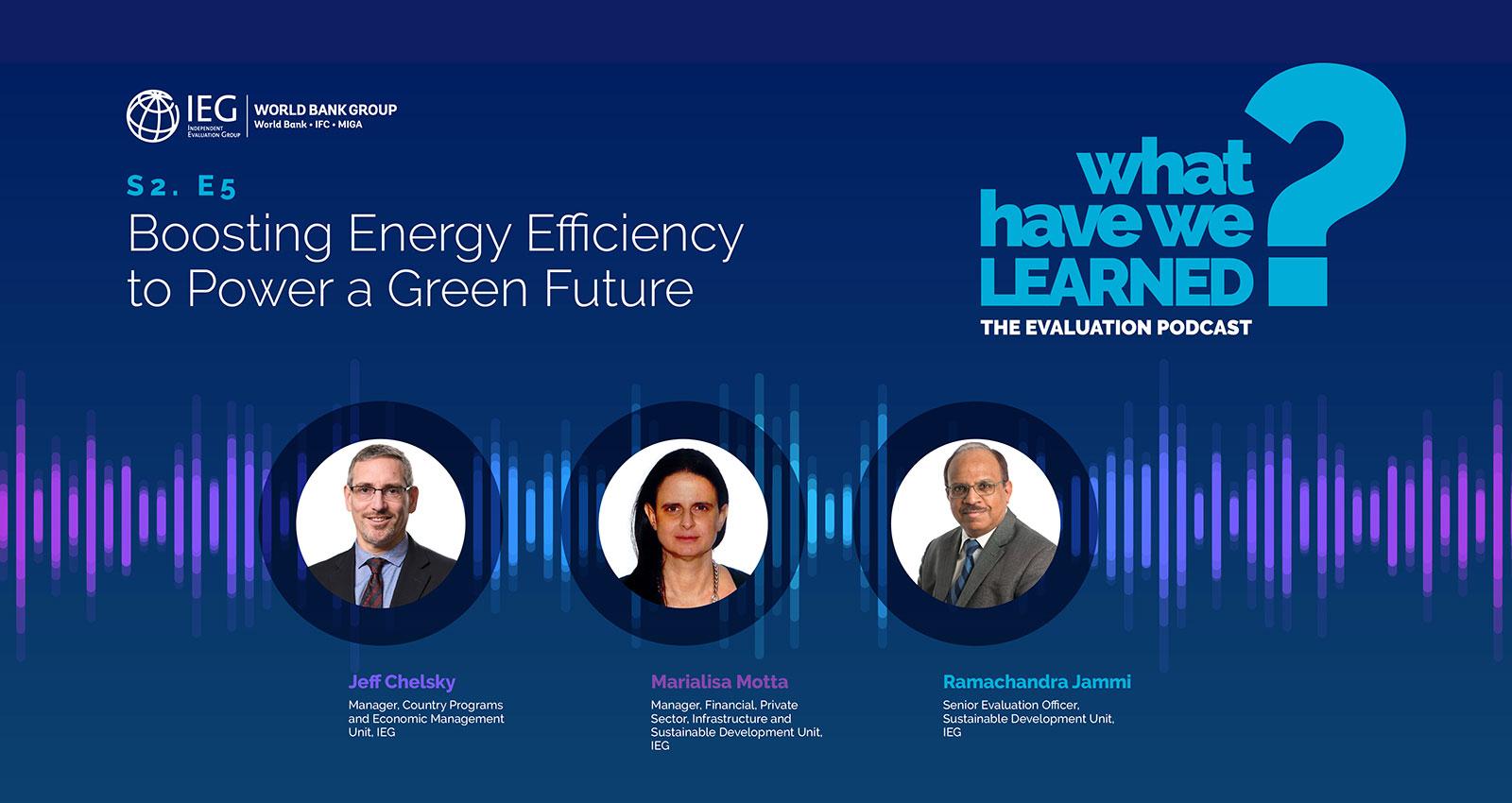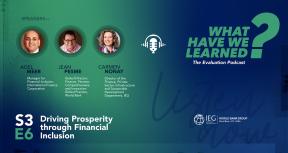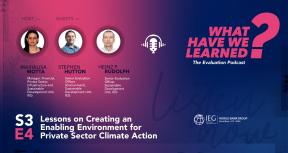Boosting energy efficiency is critical for addressing climate change. The energy sector is estimated to account for more than two-thirds of total greenhouse gas emissions globally and improving energy efficiency could contribute up to 40% towards reducing greenhouse gas emissions by 2030. Are the World Bank and its partners fully realizing the immense potential of energy efficiency advancements? What factors are slowing down the scaling up of impactful energy efficiency interventions?
In this episode, Marialisa Motta and Ramachandra Jammi join host Jeff Chelsky to unpack lessons from IEG’s evaluation on World Bank Group Support to Demand-Side Energy Efficiency. Marialisa is manager of IEG’s Finance Private Sector Infrastructure and Sustainable Development Evaluation Unit and Rama is Senior Evaluation Officer in IEG and is the lead of IEG’s energy efficiency evaluation.
Listen on Spotify, or Apple Podcasts.
Related Resources
- Blog: Untapped potential for decarbonization: Scaling up energy efficiency
- Evaluation Insight Note: Transport Decarbonization
- Evaluation: World Bank Group’s support for electricity supply from renewable energy resources, 2000–2017
- Evaluation: World Bank Group Support to Electricity Access, FY2000-2014
TRANSCRIPT
Marialisa Motta
Achieving net-zero carbon emissions by 2050, which is needed to hold climate change, requires tripling the current rate of improvement in global energy efficiency. And to get there, people and governments and private companies must change their mindset and think of energy efficiency, not as a way to save money, but as a way to make a difference.
Jeff Chelsky
Today we're going to talk about recent IEG work on World Bank Group's support for energy efficiency. Energy efficiency is essentially about using less energy to do the same work. For example, energy efficient buildings that use less energy to heat, cool and run appliances. Or energy efficient manufacturing facilities that use less energy to produce goods. Boosting energy efficiency is critical for addressing climate change and has the potential to decouple growth from greenhouse gas emissions. The energy sector is estimated to account for more than two thirds of total greenhouse gas emissions globally. And improving energy efficiency can contribute up to 40% in greenhouse gas reductions by 2030. Efforts to enhance energy efficiency have intensified in recent years as they have the potential to increase energy security and contribute to job creation, productivity and better health.
IEG recently published an evaluation of World Bank Group's support for enhancing demand side energy efficiency. The evaluation looks at energy use by households, commercial industrial firms, and by the public sector. This evaluation compliments two earlier IEG evaluations: one on energy access and the other on renewable energy, which together focus on World Bank Group support for energy supply, including power generation and distribution. I'm joined today by Marialisa Motta and Rama Jammi, who led the production of IEG’s Energy Efficiency Evaluation. We're going to discuss what they found and the implications of their evaluation for World Bank efforts to enhance energy efficiency in developing economies. Marialisa is manager of the Finance Private Sector Infrastructure and Sustainable Development Evaluation Unit in IEG. And Rama is Senior Evaluation Officer in IEG and is the lead of the Energy Efficiency Evaluation.
Marialisa, can you tell us a bit about what the World Bank Group does to support greater energy efficiency in developing economies?
Marialisa
Thanks Jeff. Sure. The importance of scaling up energy efficiency cannot be underestimated. Achieving net-zero carbon emissions by 2050, which is needed to hold climate change, requires tripling the current rate of improvement in global energy efficiency. These in turn require closing a $500 billion annual gap in global investments in energy efficiency, from approximately 300 billion in 2021 to 800 billion by 2030 and beyond. These gaps are big and require action at scale from the public and the private sector.
World Bank projects supported changes to regulations such as tariff reforms, revisions to building codes, introduction of energy standards for appliances, through development policy operations. The bank also provided loans directly to state-owned enterprises to retrofit their buildings. For example, in India, Uzbekistan and Armenia. MIGA's guarantees also support the retrofitting of buildings, especially of large public hospitals and clinics. For example, in Turkey. The IFC financed loans to private companies, being the private arm of the World Bank Group, to retrofit their buildings or to buy energy efficient equipment.
In Bangladesh and in Eastern Europe, the IFC also provided advisory services to help private companies adopt energy efficiency standards such as the EDGE Standard (Excellence in Design for Greater Efficiency). Finally, the IFC, together with other partners, also issued green bonds which promoted the use of green building standards in several companies. These are companies that needed to meet the standards to qualify for green construction financing through the green bonds. This happened for example in Colombia.
Now these examples are part of the portfolio the IEG evaluation reviewed and assessed. The portfolio includes about 400 projects in 82 countries that were worth about 18 billion and were approved between 2011 and 2020.
JC
Great, thanks. That's very clear. Rama, your evaluation finds that the World Bank Group has been effective overall in its energy efficiency interventions, but has not succeeded at scaling them up. Can you explain a bit what this means? And say a bit about what worked well and what prevented wider impact?
Ramachandra Jammi
Thank you, Jeff. I will focus on the first part of the question and let Marialisa address the matter relating to scaling up. The evaluation indeed finds that the World Bank Group's individual projects have been effective overall at supporting energy efficiency across the public and private sectors. World Bank's lending initiatives were mostly effective in achieving energy savings and in reducing carbon emissions, which are related. IFC investments had mixed results, but this was partly because they set overly ambitious targets in some cases. But the pairing of IFC investment and its advisory services worked very well. The evaluation also finds that the World Bank Group's projects targeted sectors that needed energy efficiency solutions the most. And these sectors are the industrial segment and buildings.
The evaluation also found that the World Bank and IFC projects were effective when they worked jointly in a country. And this was clearly the case in India, in Colombia, and in Vietnam, where various interventions from the two institutions helped mobilize private sector funds and create energy efficiency markets, which is a very crucial requirement.
The evaluation also found that the World Bank Group's lending worked particularly well when it was provided in combination with co-financiers, such as the Global Environment Facility (GEF), the Clean Technology Fund, the Green Climate Fund, and other development banks.
JC
Very clear. Thanks. Marialisa?
MM
The other side of the coin is indeed that the World Bank Group has not been successful at scaling up its interventions. World Bank Group projects were overall successful as Rama said, but one at a time.
Scale-up occurs in two ways. One is vertically, for example by retrofitting hundreds of buildings after initially retrofitting only a few. And the second one is horizontally. For example, introducing energy efficiency measures along supply chains.
If we take, for example the construction sector, this means introducing energy efficiency measures in the production of cement, in the transport of cement, in the construction of the buildings. Both vertical and horizontal scale-up are important. But horizontal scale-up is particularly critical, as it facilitates the adoption of energy efficiency solutions across different sectors and therefore it facilitates the reduction of indirect emissions, not just the emissions that come out from heating or cooling a specific building. These are really the emissions that happen along the supply chain and we need to reduce to scale-up.
Now on your question Jeff, on what prevented scale-up and achievement of wider impact. The evaluation identifies three factors. The first one is that clients ask the Bank Group for support on electricity generation much more than on energy efficiency. The second is that some countries have below-cost energy prices, which act as a disincentive for adopting energy efficiency measures. And the third factor is that social economic outcomes of energy efficiency interventions, for example job creation, increasing productivity of the private companies but also state-owned enterprises, are often not measured in World Bank Group projects. This reduces the relevance of energy efficiency interventions. Why? It's a bit of vicious cycle: because we don't measure enough then we don't communicate the benefits of energy and efficiency interventions to governments and as a result governments continue to focus on electricity generation much more than energy efficiency.
JC
In your evaluation, did you find examples of success in scaling up energy efficiency that can help serve as models for future support?
RJ
Indeed, Jeff. And we have good examples both for the World Bank and for the IFC. For the World Bank, one effort that stands out is the India Energy Scale-Up Program, a successful example of vertical scale-up. The project helped create a risk sharing facility, which was an innovation, and allowed 5,000 micro, small and medium enterprises to introduce energy efficiency solutions.
An example that stands out for IFC is its support to the textile sector in Bangladesh. And here the project succeeded in helping horizontal scale-up as the it helped the actors of the entire textile industry chain, including spinning, weaving and wet processing, to adopt cleaner production practices all through the sequence.
There are several other successful examples of joint vertical and horizontal scale-up. And among these I would mention an IFC project in Eastern Europe, which supported the adoption of energy efficiency standards, such as EDGE, in over one hundred stores and in the whole logistic fleet carrying goods to these stores that are part of a retail chain.
ESMAP, a World Bank Global Program that supports sustainable energy solutions, has been effective at promoting some horizontal scale-up across sectors, including the transport sector. IFC and MIGA, which is the third unit of the World Bank Group's umbrella, have been particularly successful at helping clients introduce EDGE and other green building standards in various countries. And these are important pre-conditions for scaling up.
JC
Now IEG’s mandate, raison d'être, is to help the World Bank Group have more impact, be better. What would you do to improve the reach of World Bank Group's support for energy efficiency?
MM
Thanks Jeff. So first of all, I think it is very important to underline that the key condition to scale-up on energy efficiency and to make a difference is a change of mindset. Moving from a focus on energy savings to a broader explicit outlook on decarbonization to reduce climate change. As you said at the beginning, energy efficiency can contribute up to 40% in greenhouse gas reduction by 2030. And to get there, people and governments and private companies must change their mindset and think of energy efficiency, not as a way to save money, but as a way to make a difference and make a dent in climate change. So that has to be in the back of our mind as we think about what other practical actions the World Bank can take to support energy efficiency.
The evaluation identifies four specific factors. The first one is demonstrating to government the impact of energy efficiency solutions, including on their climate-related benefits as well as the socioeconomic benefits that I mentioned earlier. Creating jobs, increasing productivity. In the evaluation we specifically recommend the World Bank Group staff include these outcomes in energy efficiency projects, as currently they're rarely mentioned.
The second factor that the evaluation identifies is to improve the overall regulatory environment for energy efficiency. This includes supporting the introduction of new laws and policies that create the incentive to increase investment, public and private investment in energy efficiency. But also incentives for governments, companies and people to adopt energy efficiency practices.
Third, the evaluation also finds that it is important to target the right countries, industries, and the right firms. These are middle income countries and lower middle-income countries that are growing fast in energy intensive sectors. Target firms include firms that operate in hard to abate industries such as chemical for example, cement production or agri processing. And also state-owned companies, state-owned enterprises. Actually these are particularly important for vertical scale-up. Estates own several buildings that can be green. They can start with 10 and then move to 100, a 1,000 and ten thousand.
And fourth, another critical factors that come out of the analysis is the use of digital and financial innovation. Especially in the countries that are low middle income but that have energy intensive sectors that are growing very fast.
JC
Let me ask you about the last point. You talked about digital and financial innovation as something that can extend the reach and impact of World Bank Group's support for energy efficiency. What specifically are you thinking of?
RJ
Yeah, I'll take that one Jeff. When we talk of digital and financial innovation, we're really talking about taking advantage of Internet and smartphone technology and using sensors, smart meters, all the modern technologies that you can combine to collect data regarding energy consumption and energy efficiency. And then feed this data back to policy makers and to users. The effect that this will have is that policy makers will become more aware of the importance of energy efficiency and the cost savings that can produce, and beneficiaries can be incentivized when they get that information.
The idea is for developing countries to leapfrog from their current status by learning from advanced countries. High-income countries can provide solutions that can be a useful reference for both middle and lower middle-income countries. An example is using cloud-based software systems such as the Opower system which allows customers to receive information on their level of energy efficiency and energy use relative to similar homes, and in a target zone in a simple graphical way. This has the effect of incentivizing them to save energy.
Examples of finance innovation include blended finance solutions and the creation of risk sharing facilities, like the one I mentioned in the context of the World Bank's India project. And partial credit risk guarantees such as the ones that the World Bank has supported in Colombia, in India, Turkey and Uzbekistan. As I also mentioned earlier, 5,000 micro, small and medium enterprises benefited from the World Bank's risk sharing facility in India. Several state-owned enterprises in Uzbekistan benefited from banks loans to green their equipment. And Turkey developed from scratch, a leasing market for energy efficiency thanks to IFC's pilot blended finance project. So that's to give you a feel of both digital and financial innovation that's been supported by the World Bank Group.
JC
Last question. How were your findings received from the World Bank Group Management?
MM
Yes, indeed Jeff. In this case, they very much welcome the analysis and the findings of the evaluation. They agreed with all recommendations. They confirmed that scaling up energy efficiency is a priority for them, and welcome our suggestions to accelerate the process. They did caution us, however, on one of the recommendations which suggested that the World Bank Group should measure indirect emissions —emissions that occur in different sectors along supply chains— in all its projects. They cautioned us and said, "This is important, we agree. But it's a complex endeavor and will require some time."
JC
Now I lied. I do have one last question. So IEG has a fairly formal process for following up on its recommendations. So what happens next with this evaluation and its findings?
MM
So the first thing that will happen is that we'll have a chance to discuss the findings with World Bank Group management. We're organizing, in fact, an event with colleagues from the Bank, the IFC and also MIGA to discuss the analysis, the findings, the recommendations. And also and especially how they can be implemented. And then, the implementation of the recommendations will be tracked down the road and management will let us know what they have implemented and how things are going, and if there's something they cannot implement and for which reason.
JC
And overseeing all of this will be the Executive Board.
MM
Indeed.
JC
Unfortunately, that's all the time we have today. I want to thank my guests, Marialisa and Rama for sharing the findings of their evaluation on the World Bank Group's support for demand site energy efficiency. This has been The Evaluation Podcast, What Have We learned? And I am your host, Jeff Chelsky. Until next time, and in keeping with today's theme, please try to do more with less. Thank you.
This Episode’s Featured Guests:









